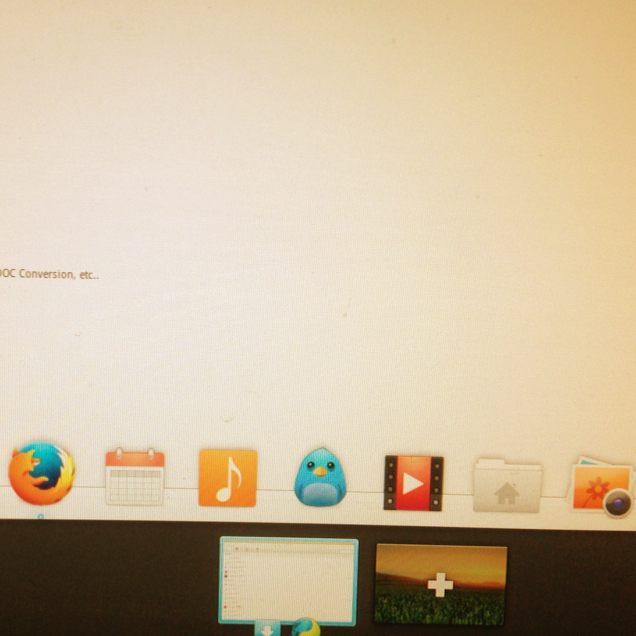
I love the workspace switching in Elementary OS. #Linux #ElementaryOS
The post Workspaces switching in Elementary OS appeared first on Leon Kilat : The Tech Experiments.

I love the workspace switching in Elementary OS. #Linux #ElementaryOS
The post Workspaces switching in Elementary OS appeared first on Leon Kilat : The Tech Experiments.
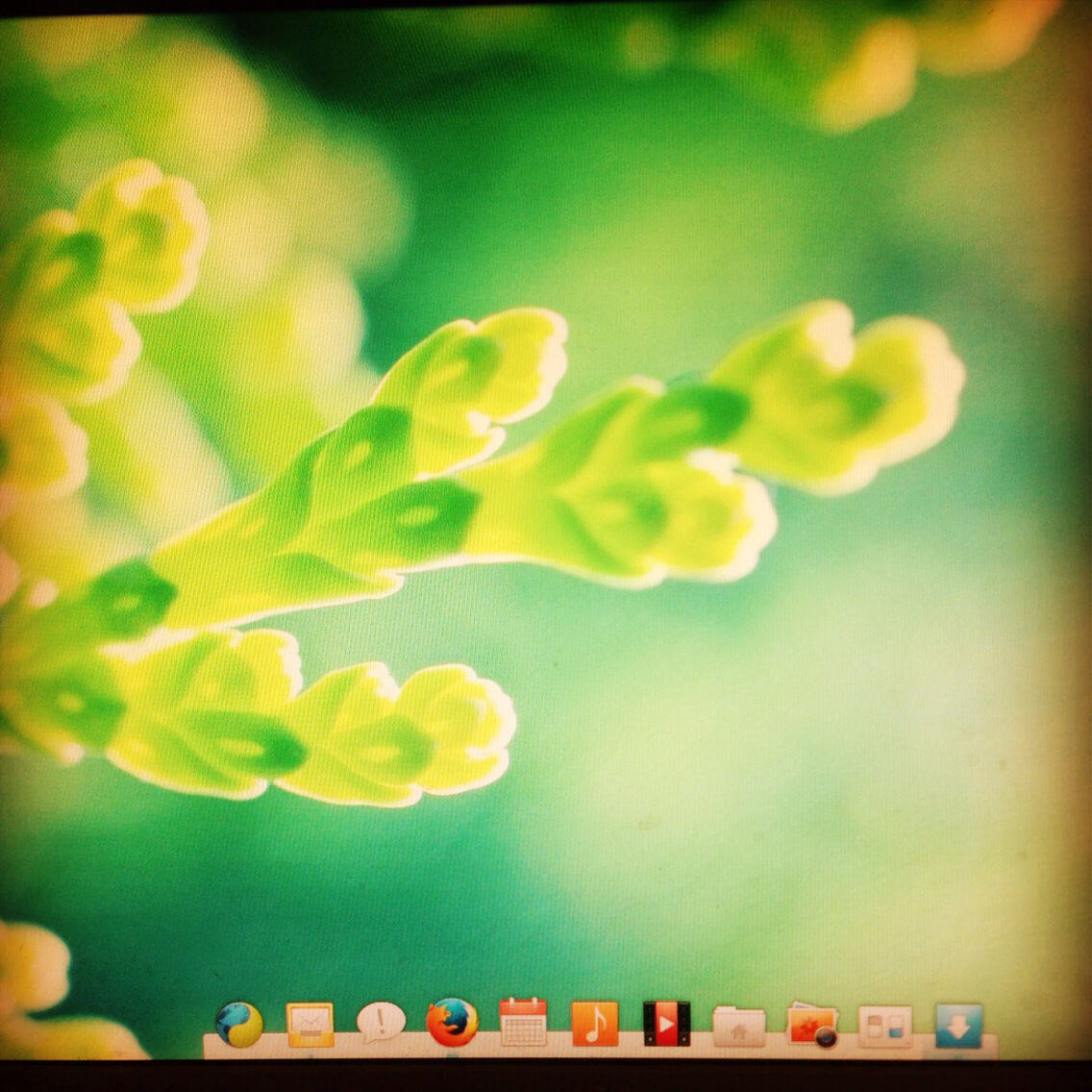
After trying out Elementary OS for a day, I decided to make it my main home desktop operating system. Elementary OS is an Ubuntu Linux-based distro that has a beautiful and simple interface and a nice selection of default apps. It also seems to respond well to modest hardware. If you’re a first-time Linux user, this is the distro to try. #Linux #elementaryOS #Ubuntu
The post Elementary, my dear PC appeared first on Leon Kilat : The Tech Experiments.
Southeast Asia is the battleground for a bruising competition among a set of cute mobile phone applications: chat apps. Up north, the battle has largely been won in their home markets, with Line taking Japan, WeChat in China and KakaoTalk in South Korea.
In SouthEast Asia, however, there is no clear winner yet, said Junde Yu, the vice president for AsiaPacific of App Annie. Line, WeChat and KakaoTalk are battling each other across the region through TV ads, billboards and celebrity endorsements.
“We send our heartfelt condolences out to good old-fashioned SMS,” App Annie said in a blog post on the subject.
Yu said the fight is more than just about getting the top market share in social messaging. The apps are “entry points to dominate mobile.”
“They are not just looking to get sticker revenues although it is big for them,” he said. Although the apps are free, they sell virtual stickers that you send to your friends in your chats.
“They are looking to use it to drive app downloads, to drive game downloads,” Yu said. He said Line was able to push one of their games to top the charts in just a few hours by promoting it in their messenger.
“This is something carriers can do when rolling out apps. You can send out text to encourage people to install and instantly you are top of the cart, you don’t need to buy ads,” he said.
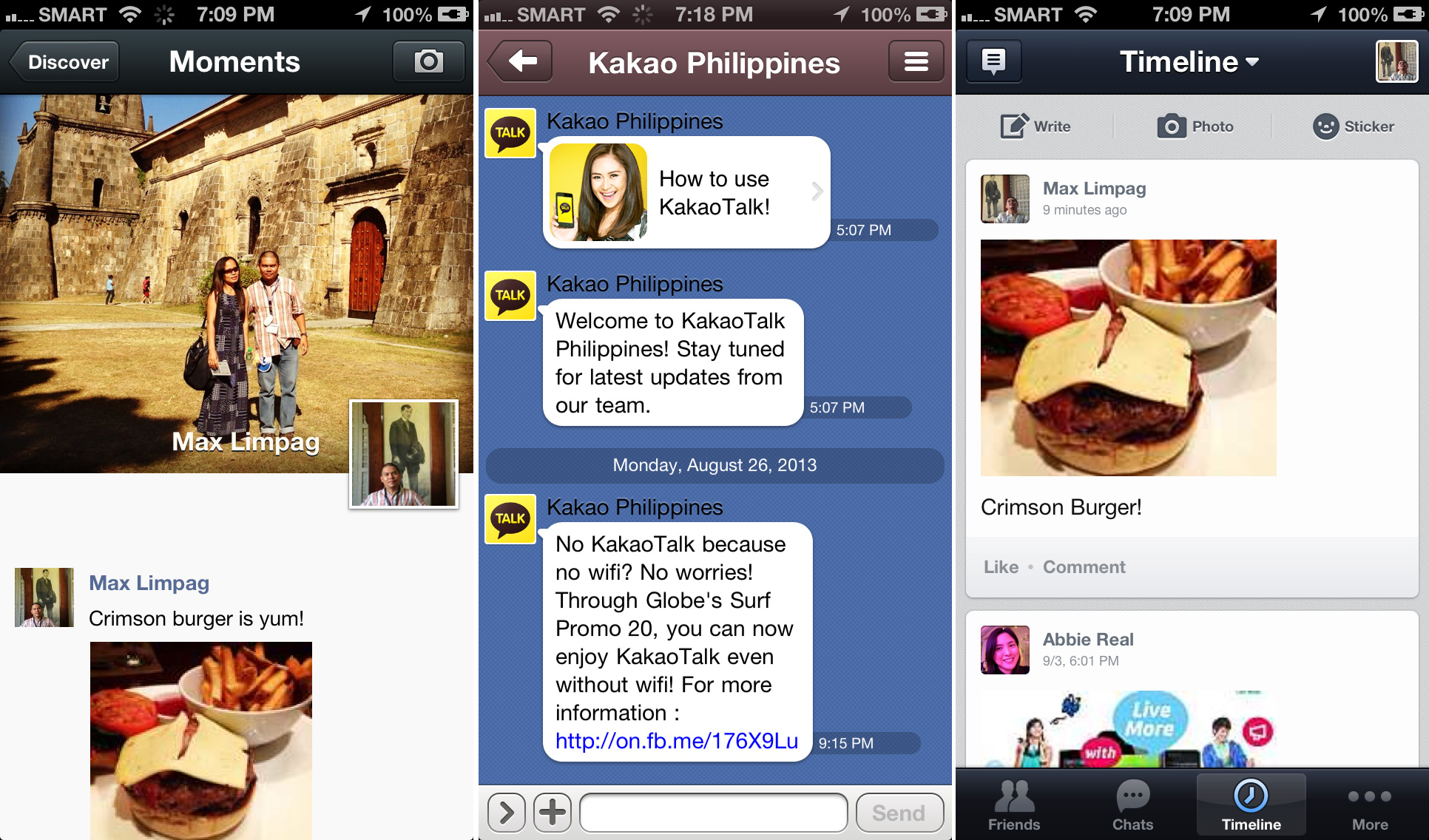
WECHAT, LINE, KAKAOTALK. These social messaging apps are “entry points to dominating on mobile.” More than messaging, these apps are also social networks. According to an app analytics company, there are no clear winners yet in most of Southeast Asia.
Chat apps and other so-called over-the-top or OTT services, which are services you use on the network of your telco provider, dominated discussions in last week’s Asian Carriers Conference in Shangri-La’s Mactan Island Resort and Spa. OTT services are disrupting the telecommunications industry and cannibalizing its revenues.
Apps like WeChat, Skype or Line allow you to send messages or make calls for free through an Internet connection, whether via Wi-Fi or your telco’s network.
Telcos will lose $32.6 billion to OTT messaging applications this year, according to Ovum, an analyst and consultancy company headquartered in London. By 2016, Ovum said the losses will add up to $54 billion. Add to that the $52 billion telcos are projected to lose to voice over Internet protocol (VoIP) applications by 2016 and the future does look challenging, an analyst said last week.
There is an opportunity for telcos to do well in the new digital landscape dominated by OTT players, another analyst said. They just have to get out of that operator mindset, said Bubbly CEO Thomas Clayton.
“Operator guys, you got to react faster,” Clayton said. He said that when a chat network dominates a country, it also helps drive smartphone adoption. He said people would want to be in the dominant network and would buy smartphones to be there.
Telcos’ responses to OTT services, according to Ovum, range from adopting a wait-and-see attitude to blocking their services to working or even competing with them.
Oscar Veronese, InternetQ SVP for Southeast Asia, told operators to partner with OTT players. “You have the consumers…they have the speed, the creativity.” Veronese said the market will “explode” in the next six months.
“You’re gonna see a massive change with people using feature phones going to smartphones,” especially cheaper Androids, Veronese said.
In the Philippines, both Smart Communications, Inc. and Globe Telecom have started offering prepaid buckets that offer unlimited use of WeChat, Line and KakaoTalk services.
Yu said Filipinos are already top downloaders of mobile phone applications. He said the country is ranked 18th globally in downloads from Google Play, which is “really high” for a country with its population and GDP figure.
In the Philippines, revenue erosion is not as apparent as that in Europe “simply because the cost of call and text here is already very low,” said Sun Cellular senior vice president Ricky Peña.
“We have the benefit of learning from the experience of other operators. The way forward is to experiment and learn the lessons the OTTs are teaching us. It’s all about giving the richer experience to customers,” said Peña, who is also the head of communication of Voyager Innovations, Inc., the innovation arm of the companies under Manny V. Pangilinan’s group.
Peña, however, said the issue is more than just messaging.
“It’s all about building a digital life experience. Right now, the buzz is all about messaging. But the bigger picture is how will this technology change people’s lives? That is what really will make your customers stickers. You will change for the better how they live, how they work, how they play,” he said.
“It’s not just all about messaging. Sure, communications is the glue that holds everything together. We also have to address the need to digitize other facets of their life like education, health, commerce – all of these things will be part of that ecosystem,” he said.
The post WeChat, Line, KakaoTalk battle for users; no clear winners yet in Southeast Asia appeared first on Leon Kilat : The Tech Experiments.
“IN 200 meters,” the Waze app on the phone said, “turn right.”
We were headed to Marco Polo Plaza Cebu and were near the Banilad flyover on our way to the IT Park when Waze, the driving application I was running on my phone, gave the direction to turn right.
Waze had determined, by going through its database of roads in Cebu and reports of traffic conditions sent in by users, that the quickest route for us was to go to that neighborhood behind Gaisano Country Mall, pass through Camp Lapu-Lapu and a small side road and emerge on our way up to the hotel.
But I’ve never passed that neighborhood behind Gaisano Country Mall for years and didn’t know whether we could find our way out of it or even whether we could get in Camp Lapu-Lapu, which is a military facility.
Although the Waze app had brought us quickly to where we were, 200 meters before Gaisano Country Mall, I had a mind to ignore the device and follow the route I’d normally take, which is to go straight Gov. M. Cuenco Ave. and then turn right to Jose Maria del Mar St. to enter IT Park.
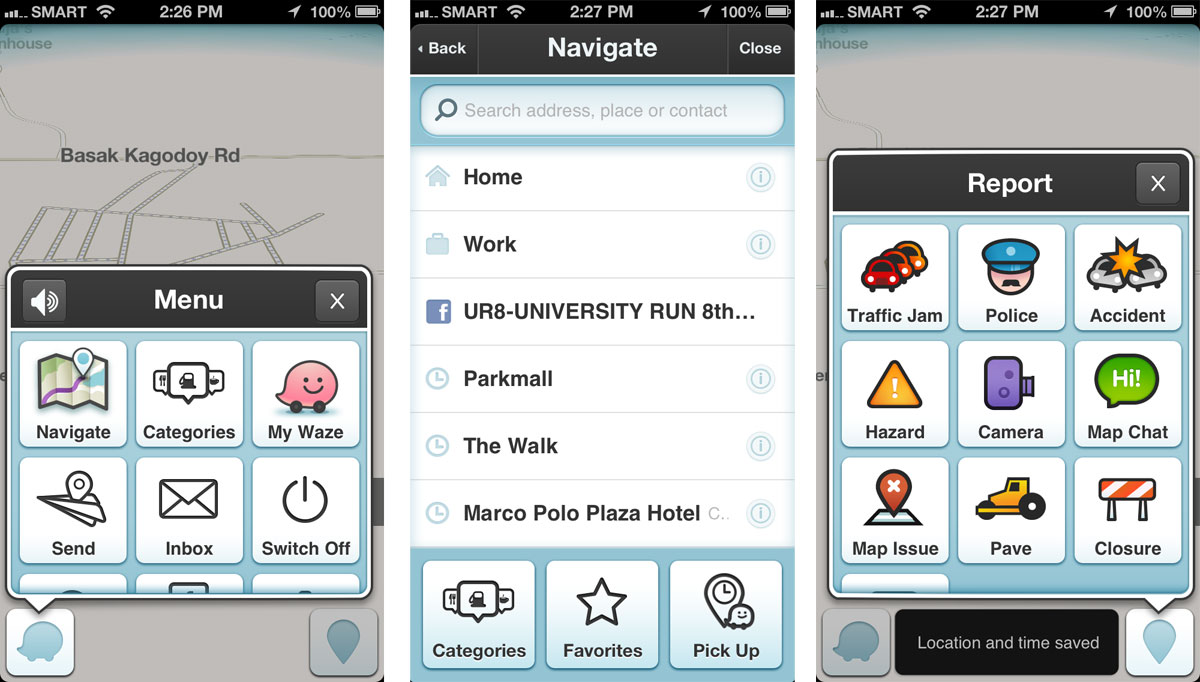
EASY TO USE. The Waze mobile app is easy to use to navigate streets and submit traffic and road incident reports.
But I decided to follow Waze’s advice, I’m testing it for a column piece anyway, I told myself. Corner by corner, the app navigated us, via voice cues, through the neighborhood near Camp Lapu-Lapu, right through the camp itself and out near JY Square.
And, as Waze had done so for weeks that I’ve been using it, we cut travel time by several minutes.
Waze, for the unfamiliar, is an application that you install into your Android or iOS device to help you navigate traffic. It uses GPS or global positioning system to track where you are, where you want to go and how you can go there fast.
It does this by getting route and driving data from the devices of its users and receiving reports from them. Users can report traffic jams and their severity, accidents, hazards and even police.
The system was founded in Israel and became very popular all over the world that Google bought it for $1.03 billion. The traffic reports are now starting to be integrated in Google Maps.
If you drive, Waze is an app that you should install. It’s for free. But for it to work, you need to turn on our phone’s GPS or location service and have a working mobile data connection.
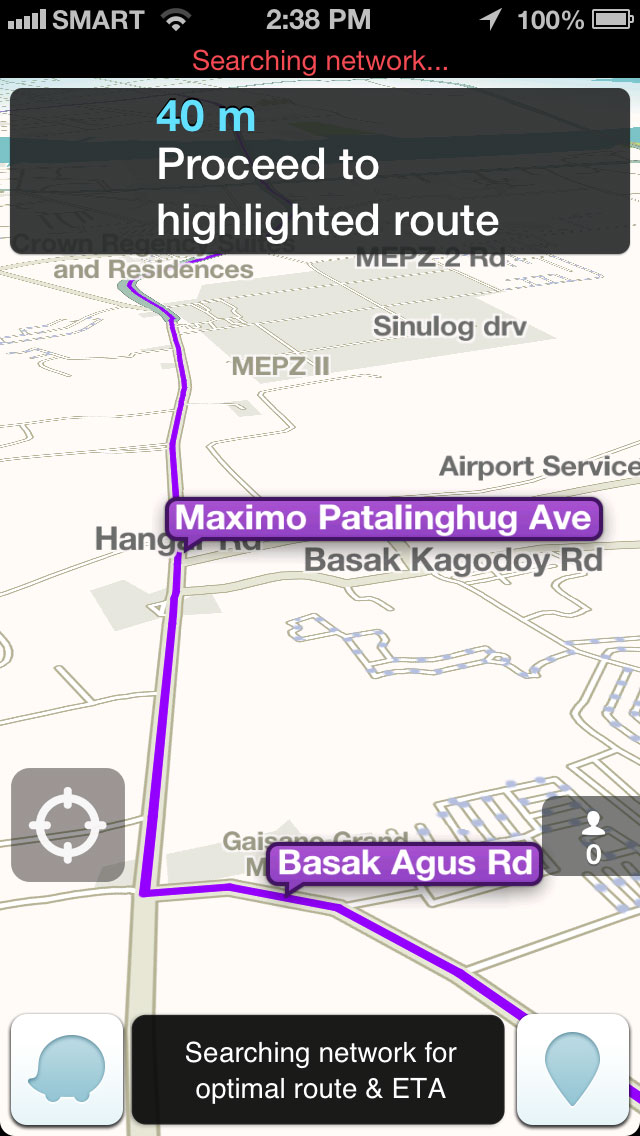
FASTEST ROUTE. Waze gives you suggested routes to where you are headed and offers the fastest way to get there, taking into account traffic conditions.
Using it is very straightforward. To go somewhere, you just choose navigate and search for the location of the place you are headed to. To simplify regular commute, it allows you to save locations you frequent like work, home etc. Reporting traffic situations is also easy, provided you have good mobile Internet connection.
The Waze app, being free and easy to deploy, is a great solution to dealing with traffic in an area like Cebu. Closed circuit cameras, which the City is deploying albeit not only for traffic but also to monitor crime, can only do so much and aren’t as useful on the phone.
It would help our situation if more people would use apps like Waze and if government can help improve the system by populating it with field reports from enforcers.
The City already has a traffic reporting system via a system built on Android phones deployed on select taxicabs. By running the Waze app in them and encouraging drivers to send reports, other commuters will be able to take advantage of that rich traffic data.
The post Waze app: how to use your phone to outsmart Cebu traffic appeared first on Leon Kilat : The Tech Experiments.
DAVAO CITY-After hitting LTE Advanced download speeds in excess of 200 megabits per second (Mbps) during tests in Manila, Smart Communications Inc. held another test in Davao City last Saturday.
PLDT and Smart Technology head Rolando Peña said he scheduled the test in Davao to show that the company’s network is able to deliver LTE Advanced throughout the country.
“I want to be able to tell my board of directors that I have personally tested the network up to Davao and that we are able to deliver the next generation LTE on a nationwide basis. To me Davao is the biggest challenge because it traverses several land-sea-land-sea type of combination,” Peña said during the test at the PLDT office in this city.
Peña stressed the importance of the company’s fiber network which spans about 71,000 kilometers. He said the “Philippines’ most extensive fiber network” is what enables them to deploy advanced networks.
Saturday’s test was attended by journalists and government officials, including a group from the Brunei Darussalam-Indonesia-Malaysia-The Philippines East Asean Growth Area (BIMP-EAGA).
“We are introducing the next generation LTE. And the next generation LTE is capable of doing theoretical speeds of more than one gigabit per second wirelessly and practical speeds of about 700 megabits per second,” Peña announced before the test of what he said was the “first level of the next generation of LTE.”
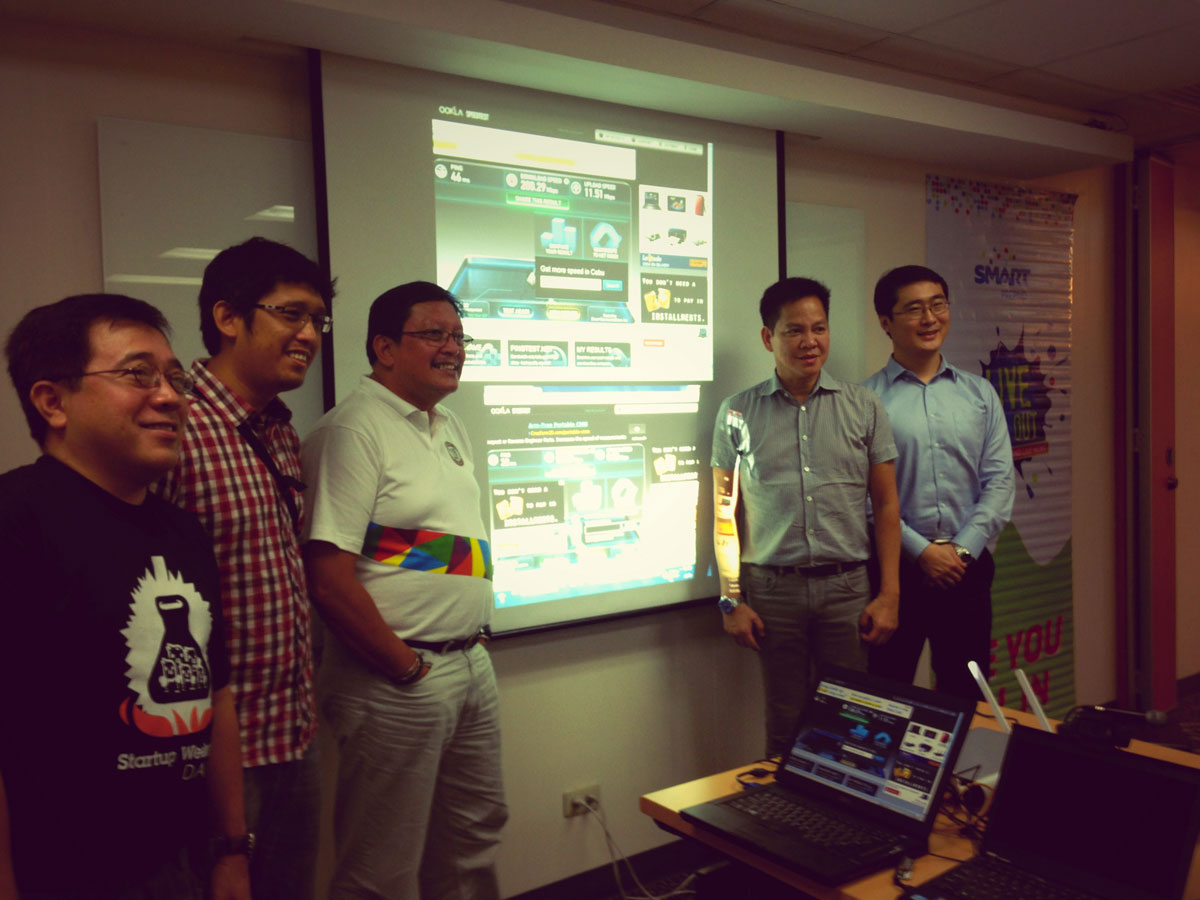
LTE ADVANCED DEMO. PLDT and Smart Technology head Rolando Peña (2nd from right) and Huawei Philippines wireless division head Li Zhi Chao pose with a projection of a speed test on an LTE Advanced network demonstration in Davao City. With them are Davao City Councilor Leo Avila III (3rd from left), the chairman of the committee on transportation and communications, his son Lester, a gamer, and Bert Barriga, executive vice president of ICT Davao. (Photo by Max Limpag)
Peña said the current LTE is capable of “practical download speeds of about 65 Mbps.” The first level of the next LTE is capable of more than thrice that, he said.
During the test conducted by Smart and a team from Huawei Philippines led by wireless division head Li Zhi Chao, they were able to hit download speeds of up to 214Mbps. Allan Siao of Smart Access Planning then demonstrated the download of a 100-megabyte file via file transfer protocol to compare speeds of the current LTE and LTE Advanced. The current LTE connection took 43 seconds to download the file while the LTE Advanced connection took just six seconds. They also demonstrated HD video communications via Skype and HD streaming video.
“It’s very inspiring. It feels like the kind of technology that Davao needs, as well as the rest of the country. Imagine the impact of such a fast speed,” said ICT Davao executive vice president Bert Barriga.
Barriga said LTE Advanced is something that can be used “for empowering small data centers, service delivery centers, across the island. It is very practical and it does not require heavy infra. It’s very efficient and small businesses can run it and manage it also.”
“Having this in Davao would bring so much opportunity,” said Davao City Councilor Leo Avila III, the chairman of the council’s committee on transportation and communications, “business and governance is already about being connected.”
Peña said they are closely looking into two areas to decide on when to do commercial rollout of LTE Advanced: the availability of compatible devices and development of applications that take advantage of the high-speed network.
He said that while Philippine consumers take from two to three years to change phones, portable Wi-Fi devices or “MyFi” units will enable people to take advantage of advanced networks without having to upgrade their phones.
On the application said, Peña said “today, most of the applications can be very well served by (current) LTE connectivity.”
Peña said the Smart network is ready to quickly deploy LTE Advanced.
“We just have to add a certain radio unit to our existing cell site and we will already be able to deliver this kind of infrastructure,” he said.
When pressed for a timeframe, Peña said he thinks commercial tests can start early next year.
He also said they are rethinking mobile Internet pricing, especially the practice of setting different fees for 3G and LTE.
“When we launched LTE, it was priced differently from 3G and we are now actually asking ourselves, why are people not adopting LTE that fast? And one answer is and we are finding this out, if we price LTE the same way as 3G – in other words, we don’t make any differentiation, whatever technology is available so long as your device can use it then use it.”
“Anyway today, pricing for mobile broadband is changing from unlimited to volume-based. So if it’s volume anyway, it doesn’t matter whether you use the fast lane or the slow lane. At the end of the day, it’s the volume transaction that matters,” he said.
The post Smart network ready for LTE Advanced: Rolando Peña appeared first on Leon Kilat : The Tech Experiments.
Diag| Memory: Current usage: 59 MB
Diag| Memory: Peak usage: 85 MB